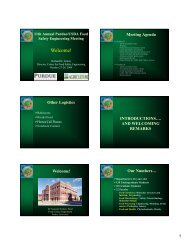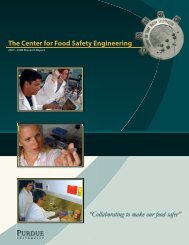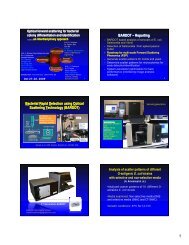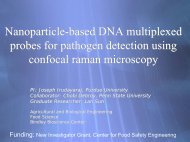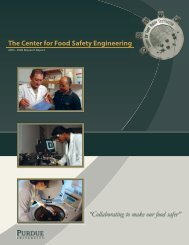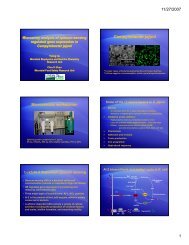bhunia talk 1 multi pathogen screening - Center for Food Safety ...
bhunia talk 1 multi pathogen screening - Center for Food Safety ...
bhunia talk 1 multi pathogen screening - Center for Food Safety ...
You also want an ePaper? Increase the reach of your titles
YUMPU automatically turns print PDFs into web optimized ePapers that Google loves.
Funding period: Jan 2003-Feb 2006<br />
Multi<strong>pathogen</strong> <strong>screening</strong> and /or<br />
confirmation via microarray detection<br />
Arun Bhunia, Mark Morgan, Shu-I Tu<br />
<strong>Center</strong> <strong>for</strong> <strong>Food</strong> <strong>Safety</strong> and Engineering,<br />
Purdue University<br />
ERRC, Wyndmoor, PA<br />
Primary objective – to develop microarray<br />
based plat<strong>for</strong>ms to detect three major<br />
<strong>pathogen</strong>s (Listeria, Salmonella, E. coli)<br />
simultaneously<br />
Focus<br />
1. Nucleic acid –based plat<strong>for</strong>m – Applegate (PI)<br />
2. Antibody- based plat<strong>for</strong>m – Bhunia (PI)<br />
Team members: BK Hahm (PD), Priya Banada (PD),<br />
Viswaprakash Nanduri (PD), Tao Geng (PD), Amanda<br />
Lathrop (GS), Hyochin Kim (GS), Andrew Gehring (USDA-<br />
ARS, ERRC)<br />
CFSE Annual Review – Oct 12-13, 2006<br />
1<br />
2<br />
Immunomicroarray <strong>for</strong> <strong>multi</strong><strong>pathogen</strong>s<br />
Essentials<br />
• Specific antibodies and immune reaction (Objective 1<br />
& 1b)<br />
• Plat<strong>for</strong>ms: Fiber optic and 96-well/slide (Objective 2)<br />
• Sample preparation strategy-PEDD (Objective 3)<br />
• Selective growth media (Objective 4)<br />
Objective 1: Antibody and antibody<br />
reaction<br />
a. Antibody Development: Genomic and<br />
proteomic approaches in antibody<br />
development <strong>for</strong> Listeria, E. coli and<br />
Salmonella.<br />
b. Antigen Expression: Effect of stress<br />
responses (media and environments) on<br />
antigen expression and immunoassays<br />
3<br />
4<br />
Objective 1a: Genomic and proteomic approaches in<br />
antibody development <strong>for</strong> Listeria, E. coli and<br />
Salmonella<br />
• Search <strong>for</strong> species-specific<br />
surface exposed amino<br />
acid sequence<br />
• Determine hydropathy<br />
profiles, surface<br />
localization, and antigenic<br />
properties<br />
• Synthesize candidate<br />
peptide (15-20 amino<br />
acid) antigen<br />
• Immunize rabbits and test<br />
<strong>for</strong> antibody production<br />
Strategies<br />
5’-TCC-CGT-ACT-GAC-ATT-CTC-3’<br />
N’- S - R - T - D - I - L -C’<br />
N’<br />
C’<br />
5<br />
Antibody<br />
E. coli-specific antibodies<br />
Anti-E. coli<br />
O157:H7 PAb<br />
2F11 MAb<br />
ST3229 PAb<br />
ST3230 PAb<br />
ST3236 PAb<br />
ST3238 PAb<br />
Anti-Salmonella<br />
PAb<br />
Anti-Salmonella<br />
CSA-1 PAb<br />
Target<br />
antigen<br />
Anti-E. coli<br />
O157:H7 PAb<br />
LPS<br />
Anti-E. coli PAb Whole cells<br />
Intimin<br />
Salmonella-specific antibodies<br />
LPS<br />
32 kDa<br />
32 kDa<br />
205 kDa<br />
25 kDa<br />
Multiple<br />
proteins<br />
Multiple<br />
proteins<br />
Antibody List<br />
Pathogen<br />
Antibody<br />
specificity<br />
E. coli O157:H7<br />
E. coli<br />
E. coli O157:H7<br />
Sal. Enteritidis<br />
Sal. Typhimurium<br />
Sal. Typhimurium<br />
Sal. Typhimurium<br />
Sal. Typhimurium<br />
Sal. Enteritidis<br />
Sal. Typhimurium<br />
Listeria–specific antibodies<br />
C11E9 MAb<br />
EM-7G1 MAb<br />
EM-6E11 MAb<br />
P66 PAb<br />
MAb-EM10<br />
Anti-Listeria<br />
PAb<br />
Lm404 PAb<br />
Lm407 PAb<br />
LmC639 PAb<br />
Target<br />
antigen<br />
66 kDa<br />
66 kDa<br />
97 and 43 kDa<br />
66 kDa<br />
104 kDa<br />
68, 62, 58, 50, 43<br />
and 30 kDa<br />
63 kDa InlB<br />
52 kDa<br />
90 kDa ActA<br />
Pathogen<br />
specificity<br />
L. mono, L.<br />
innocua<br />
L. mono<br />
Listeria spp<br />
Listeria spp<br />
Listeria spp<br />
Listeria spp<br />
L. mono<br />
Listeria spp<br />
L. mono<br />
6<br />
1
Objective 1b: Effect of stress responses<br />
on antigen expression and immunoassays<br />
Motivation: As biosensors are becoming increasingly<br />
sensitive, a slight reductions in immune reactions due to<br />
“cellular or environmental factors” will result in “false” results<br />
Effect of selective enrichment media on InlB and<br />
ActA expression <strong>for</strong> L. mono –specific antibodies<br />
BHI<br />
V7 (1/2a)<br />
Scott A (4b)<br />
MurrayB (4ab)<br />
ATCC 19114 (4a)<br />
SLCC 2479 (3c)<br />
ATCC 7644 (1/2c)<br />
F4233 (1/2b)<br />
ATCC 2540 (3b)<br />
ATCC 19117 (4d)<br />
ATCC 19118 (4e)<br />
ATCC 19116 (4c)<br />
SLCC 2482 (7)<br />
SLCC 2373 (3a)<br />
BHI<br />
V7 (1/2a)<br />
Scott A (4b)<br />
MurrayB (4ab)<br />
ATCC 19114 (4a)<br />
SLCC 2479 (3c)<br />
ATCC 7644 (1/2c)<br />
F4233 (1/2b)<br />
ATCC 2540 (3b)<br />
ATCC 19117 (4d)<br />
ATCC 19118 (4e)<br />
ATCC 19116 (4c)<br />
SLCC 2482 (7)<br />
SLCC 2373 (3a)<br />
• Effect of selective enrichment broths on InlB,<br />
ActA and several unknown antigens in L.<br />
monocytogenes<br />
• Effect of environmental stresses on antibody<br />
based detection of E. coli O157:H7, S. enterica<br />
and L. monocytogenes<br />
7<br />
LB<br />
BLEB<br />
UVM No expression observed<br />
FB<br />
anti-InlB PAb (Lm404)<br />
Lathrop et al 2006 (Submitted)<br />
LB<br />
BLEB<br />
UVM<br />
FB<br />
anti-ActA PAb (LmC369)<br />
8<br />
RT-PCR ELISA<br />
OD490<br />
OD490<br />
M<br />
F4244 (4b)<br />
F4244-ActA<br />
2<br />
1.5<br />
1<br />
0.5<br />
0<br />
LB BHI BLEB UVM FB<br />
2<br />
F4244-InlB<br />
1.5<br />
1<br />
0.5<br />
0<br />
LB BHI BLEB UVM FB<br />
actA inlB 16S<br />
LB<br />
BHI<br />
BLEB<br />
UVM<br />
FB<br />
LB<br />
BHI<br />
BLEB<br />
UVM<br />
FB<br />
LB<br />
BHI<br />
BLEB<br />
UVM<br />
FB<br />
No temp ctrl<br />
M<br />
~90 bp<br />
OD490<br />
OD490<br />
M<br />
F4233 (1/2b)<br />
1.5<br />
F4233-ActA<br />
1<br />
0.5<br />
0<br />
LB BHI BLEB UVM FB<br />
2 F4233-InlB<br />
1.5<br />
1<br />
0.5<br />
0<br />
LB BHI BLEB UVM FB<br />
actA inlB 16S<br />
LB<br />
BHI<br />
BLEB<br />
UVM<br />
FB<br />
LB<br />
BHI<br />
BLEB<br />
UVM<br />
FB<br />
LB<br />
BHI<br />
BLEB<br />
UVM<br />
FB<br />
9<br />
M<br />
Transmission electron microscopic (TEM) analysis of InlB<br />
and ActA expression in different media<br />
LB<br />
BLEB<br />
PAb<br />
Lm404<br />
PAb<br />
LmC369<br />
(a) InlB<br />
(c) ActA<br />
(b) InlB<br />
(d) ActA<br />
InlB<br />
ActA<br />
10<br />
Effect of enrichment broth on antigen<br />
expression <strong>for</strong> a Listeria specific PAb<br />
Protein Identity<br />
Calculated<br />
Gene name<br />
molecular mass<br />
Putative LPXTG-motif cell wall<br />
65 kDa<br />
anchor domain protein<br />
Lmo 0610 62,841.1 kDa<br />
58 kDa<br />
Flavocytochrome C Fumarate<br />
Reductase chain A homolog<br />
Lmo 0355 54,462.4 kDa<br />
eno<br />
50 kDa Enolase 46,472.4 kDa<br />
(Lmo 2455)<br />
45 kDa<br />
Glyceraldehyde 3-phosphate gap<br />
36,286.2 kDa<br />
dehydrogenase (Lmo 2459)<br />
35 kDa<br />
Putative phosphosugar binding protein<br />
Hypothetical regulator<br />
Lmo 0041 30,113.7 kDa<br />
Effect of environmental stresses on antibody<br />
based detection of E. coli O157:H7, S. enterica<br />
and L. monocytogenes<br />
Stress conditions investigated<br />
• Heat 45 o C; Cold (4 o C); Acid (pH 5.0); Salt<br />
(NaCl- 5.5%), oxidative stress (H 2 O 2 ;15 mM,<br />
ethanol (5%)<br />
Duration<br />
• Short-term (3h)<br />
• Long term (>6 h)<br />
Geng et al. 2006. J. <strong>Food</strong> Prot. 69(8): 1879-1886<br />
Hahm and Bhunia. 2006. J. Appl. Microbiol. 100:1017-1027<br />
Lm PAb 11<br />
12<br />
2
Western blot analysis of antigen expression with<br />
long-term combined stress<br />
60 kDa<br />
36 kDa<br />
30 kDa<br />
25 kDa<br />
_<br />
_<br />
_<br />
_<br />
Sal. Enteritidis PAb (our lab)<br />
37°C, no stress<br />
12°C, pH 5.5,<br />
3.5% NaCl<br />
4°C, pH 5.5,<br />
3.5% NaCl<br />
6 24 120 6 24 120 6 24 120 h<br />
68 kDa<br />
62 kDa<br />
58 kDa<br />
50 kDa<br />
43 kDa<br />
30 kDa<br />
L. monocytogenes PAb (our lab)<br />
_<br />
_<br />
_<br />
_<br />
_<br />
_<br />
37°C, no stress<br />
12°C, pH 5.5,<br />
3.5% NaCl<br />
6 24 120 6 24 120<br />
4°C, pH 5.5,<br />
3.5% NaCl<br />
6 24<br />
120 h<br />
ELISA490+SD<br />
2.5<br />
2.0<br />
1.5<br />
1.0<br />
0.5<br />
0.0<br />
Examination of antibody reactions with bacteria<br />
grown in hotdogs in the presence of stress<br />
E.coliO 157:H7<br />
PAb (KPL)<br />
ELISA analysis<br />
Sal.C SA-1 PAb<br />
(KPL)<br />
37`C,no stress<br />
Sal.Enteritidis<br />
PAb (ourlab)<br />
12`C,pH 5.5,NaCl3.5%<br />
L.<br />
monocytogenes<br />
PAb (ourlab)<br />
60 kDa<br />
_<br />
36 kDa _<br />
30 kDa _<br />
25 kDa<br />
_<br />
Western blot analysis<br />
Control<br />
Stressed<br />
Control<br />
→<br />
E. coli<br />
O157:H<br />
7 PAb<br />
(KPL)<br />
Stressed<br />
→<br />
Control<br />
→<br />
Stressed<br />
Sal. Sal.<br />
CSA-1 Enteriti<br />
PAb dis PAb<br />
(KPL) (our lab)<br />
Control<br />
Stressed<br />
68 kDa<br />
62 kDa<br />
58 kDa<br />
50 kDa<br />
43 kDa<br />
30 kDa<br />
L.<br />
monocytogenes<br />
PAb (our lab)<br />
_<br />
_<br />
_<br />
_<br />
_<br />
_<br />
13<br />
14<br />
Summary: ELISA response to environmental stress<br />
Antibody<br />
E. coli O157:H7 PAb<br />
(KPL)<br />
Sal . CSA-1 PAb<br />
(KPL)<br />
Sal . Enteritidis PAb<br />
L. monocytogenes PAb<br />
ELISA response<br />
Stress<br />
(Compared to<br />
control -37C)<br />
4°C 16% ↓<br />
Short-term (3 h)<br />
45°C 12% ↓<br />
5.5% NaCl 15% ↓<br />
Long-term and combined 4°C up to 6 h 13% ↓<br />
(pH 5.5, 3.5% NaCl) 12°C up to 6 h 33% ↓<br />
Short-term (3 h) 4°C 34% ↓<br />
Long-term and combined<br />
(pH 5.5, 3.5% NaCl)<br />
Short-term (3 h)<br />
Long-term and combined<br />
(pH 5.5, 3.5% NaCl)<br />
Short-term (3 h)<br />
Long-term and combined<br />
(pH 5.5, 3.5% NaCl)<br />
4°C or 12°C up to 120<br />
h<br />
13-40% ↓<br />
4°C 48% ↓<br />
45°C 37% ↓<br />
5.5% NaCl 30% ↓<br />
15 mM H2O2 20% ↓<br />
4°C up to 120 h 32% ↓<br />
pH 5.5<br />
44% ↑<br />
5.5% NaCl 100% ↑<br />
5% ethanol 53% ↑<br />
45°C 53% ↑<br />
4°C up to 120 h 40% ↓<br />
4°C or 12°C up to 24 h 8-30% ↑<br />
15<br />
Objective 2: Fiber optic sensor <strong>for</strong> food<br />
<strong>pathogen</strong>s<br />
• Listeria monocytogenes<br />
• E. coli O157:H7<br />
• Salmonella Enteritidis<br />
16<br />
Fiber optic sensor <strong>for</strong> <strong>pathogen</strong> detection<br />
Detector<br />
FO based detection of L. monocytogenes from<br />
inoculated meat samples – after 20 h-enrichment<br />
F<br />
Fluorescent<br />
molecules<br />
Laser detector<br />
Fiber<br />
laser<br />
Evanescent wave<br />
Signal (pA<br />
2500<br />
2000<br />
1500<br />
1000<br />
Bologna<br />
Hotdog<br />
(1) (2) (3)<br />
500<br />
top middle bottom<br />
0<br />
10^1 inoculum 10^2 inoculum 10^3 inoculum neg control pos control<br />
17<br />
Geng et al. 2004 Appl. Environ. Microbiol. 70:6138-6146<br />
18<br />
3
L. monocytogenes detection using RAPTOR<br />
Detection of cells with fiber optic sensor grown in<br />
BHI or EC at 2 h intervals<br />
Continous detection of E. coli O157:H7 grown in BHI, EC or GB at 2 h interval<br />
Concentration of E. coli grown in BHI<br />
1.0E+08<br />
3000<br />
Concentration of E. coli grown in EC<br />
10 2 10 3 10 4 10 5 10 6 10 7 10 8 10 9 10 10 10 5 10 6 10 7 10 8 10 9 Concentration of E. coli grown in GB w/ EC<br />
1.0E+07<br />
250<br />
250<br />
LM PAb (0.01mg/ml)<br />
400<br />
400<br />
2500<br />
L. monocytogenes<br />
1.0E+06<br />
LM PAb (0.02mg/ml)<br />
200<br />
LM P66 (0.01mg/ml)<br />
200<br />
Antibody devoid<br />
350 E. fecalis<br />
350<br />
LM P66 (0.02mg/ml)<br />
2000<br />
1.0E+05<br />
L. rhamnosus<br />
150<br />
150<br />
300<br />
300<br />
1.0E+04<br />
1500<br />
250<br />
250<br />
100<br />
100<br />
1.0E+03<br />
200<br />
200<br />
1000<br />
50<br />
50<br />
1.0E+02<br />
150<br />
150<br />
500<br />
0<br />
0<br />
1.0E+01<br />
100<br />
100<br />
-50<br />
-50<br />
50<br />
50<br />
0<br />
1.0E+00<br />
0 2 4 6 8<br />
0<br />
0<br />
-100<br />
-100<br />
Time (hours)<br />
10 2 10 3 10 4 10 5 10 6 10 7 10 8 10 9 10 10<br />
10 5 10 6 10 7 10 8 10 9<br />
Listeria monocytogenes,cfu/ml<br />
CONCENTRATION OF BACTERIA, cfu/ml<br />
PBS Hotdog<br />
Geng et al 2006. Sensors 6:796-807<br />
19<br />
20<br />
Nanduri et al 2006. Sensors 6:808-822<br />
Signal,pA<br />
coupon<br />
RAPTOR<br />
SIGNAL,pA<br />
Signals (pA)<br />
4000<br />
Signals from E. coli grown in BHI<br />
1.0E+10<br />
Signals from E. coli grown in EC<br />
1.0E+09<br />
3500<br />
Signals from E. coli grown in GB w/ EC<br />
E. coli concentration<br />
(CFU/ml)<br />
Summary: Fiber optic sensor <strong>for</strong> food<br />
<strong>pathogen</strong>s<br />
Objective 3. Sample preparation strategy<br />
<strong>for</strong> use with microarray plat<strong>for</strong>ms<br />
Pathogen<br />
Listeria<br />
monocytogenes<br />
E. coli O157: H7<br />
SLT<br />
Salmonella<br />
Detection limit Detection<br />
time<br />
10 3 cfu/ml<br />
23 h<br />
10 4 -10 5 cfu/ml meat<br />
10 3 cfu/ml meat<br />
0.5 ug/ml<br />
10 4 cfu/ml<br />
4-6 h<br />
<br />
Publications<br />
•Geng et al. 2004. AEM. 70:<br />
6138<br />
•Nanduri et al 2006. Sensors,<br />
6:808<br />
•Kim et al. 2006. Key Eng.<br />
Materials<br />
•Geng et al. 2006. Sensors,<br />
6:796<br />
•Tu et al. 2006. SPIE<br />
•Morgan et al. 2006. Key<br />
Eng. Materials<br />
21<br />
• Pathogen enrichment<br />
detection device<br />
(PEDD)<br />
• Self-contained, easyto-use<br />
device to<br />
deliver particle–free<br />
and pH adjusted<br />
bacterial suspension<br />
22<br />
Per<strong>for</strong>mance evaluation of<br />
PEDD with food sample<br />
Growth of <strong>pathogen</strong>s spiked onto food sample<br />
in PEDD<br />
Pathogen<br />
<strong>Food</strong><br />
sample<br />
Media<br />
Growth Detection<br />
10<br />
E. coli O157:H7 Sal. Typhimurium L. monocytogenes<br />
12<br />
10<br />
E. coli O157:H7<br />
Ground<br />
beef<br />
mEC +<br />
novobiocin<br />
CT-SMAC<br />
Log CFU/m<br />
8<br />
6<br />
4<br />
Log CFU/m<br />
10<br />
8<br />
6<br />
4<br />
Log CFU/m<br />
8<br />
6<br />
4<br />
Salmonella<br />
Typhimurium<br />
Egg<br />
RV<br />
XLD<br />
2<br />
0<br />
0 4 8 12 16 20 24<br />
Time (h)<br />
2<br />
0<br />
0 4 8 12 16 20 24<br />
Time (h)<br />
2<br />
0<br />
0 4 8 12 16 20 24<br />
Time (h)<br />
Listeria<br />
monocytogenes<br />
Hotdog<br />
BLEB<br />
MOX<br />
PEDD 1 CFU/ml PEDD 10 CFU/ml PEDD 100 CFU/ml<br />
Bag 1 CFU/ml Bag 10 CFU/ml Bag 100 CFU/ml<br />
23<br />
24<br />
4
Lateral flow<br />
immunoassay of L.<br />
monocytogenes<br />
retrieved from<br />
PEDD<br />
PEDD<br />
0 1 10 100 CFU/g<br />
PEDD<br />
BAG<br />
E. coli O157:H7<br />
0 1 10 100 CFU/g<br />
Salmonella Typhimurium<br />
0 1 10 100 CFU/g<br />
8 h incubation<br />
PEDD<br />
BAG<br />
BAG<br />
8 h incubation<br />
25<br />
10 h incubation<br />
26<br />
After<br />
Be<strong>for</strong>e<br />
PCR tube<br />
PCR analysis E. coli O157:H7 culture be<strong>for</strong>e<br />
or after passing through the cartridge<br />
8 h 10 h 12 h<br />
after be<strong>for</strong>e after be<strong>for</strong>e after be<strong>for</strong>e<br />
M 0 1 10 100 0 1 10 100 0 1 10 100 0 1 10 100 0 1 10 100 0 1 10 100<br />
M : 100 bp DNA ladder<br />
0, 1, 10, 100: CFU/ml of inoculation<br />
PCR mix<br />
27<br />
eaeA<br />
stx2<br />
stx1<br />
Objective 4: Formulation of selective<br />
universal enrichment broth <strong>for</strong><br />
Salmonella, E. coli and Listeria (SEL)<br />
• Media is called “SEL – Salmonella, E. coli<br />
and Listeria<br />
• Base – Buffered Listeria Enrichment Broth<br />
(BLEB) with acriflavin, cyclohexamide,<br />
fosfomycin, nalidixic acid)<br />
• Media per<strong>for</strong>mance will be addressed in our<br />
next project.<br />
Hyochin Kim 2006<br />
28<br />
Multi<strong>pathogen</strong> Screening<br />
Fiber optic<br />
Sensor<br />
Test sample<br />
Enrichment in PEDD using universal<br />
selective enrichment broth (eg., SEL media)<br />
Microarray<br />
ELISA<br />
29<br />
Need work!<br />
Conclusions<br />
• Specific antibodies are available <strong>for</strong><br />
immunomicroarray assay<br />
• Stress and media affect antibody reaction either by<br />
affecting transcription, translation or translocation<br />
• Data with physiologically stressed bacterial cells would<br />
be helpful in <strong>for</strong>mulating assay procedure <strong>for</strong> optimum<br />
signal<br />
• Fiber optic sensor data are promising and <strong>multi</strong>plex<br />
assay could be developed using the automated system-<br />
RAPTOR<br />
• PEDD system removes particles and inhibitors from<br />
food and should be useful <strong>for</strong> detection by biosensor<br />
plat<strong>for</strong>ms<br />
30<br />
5



